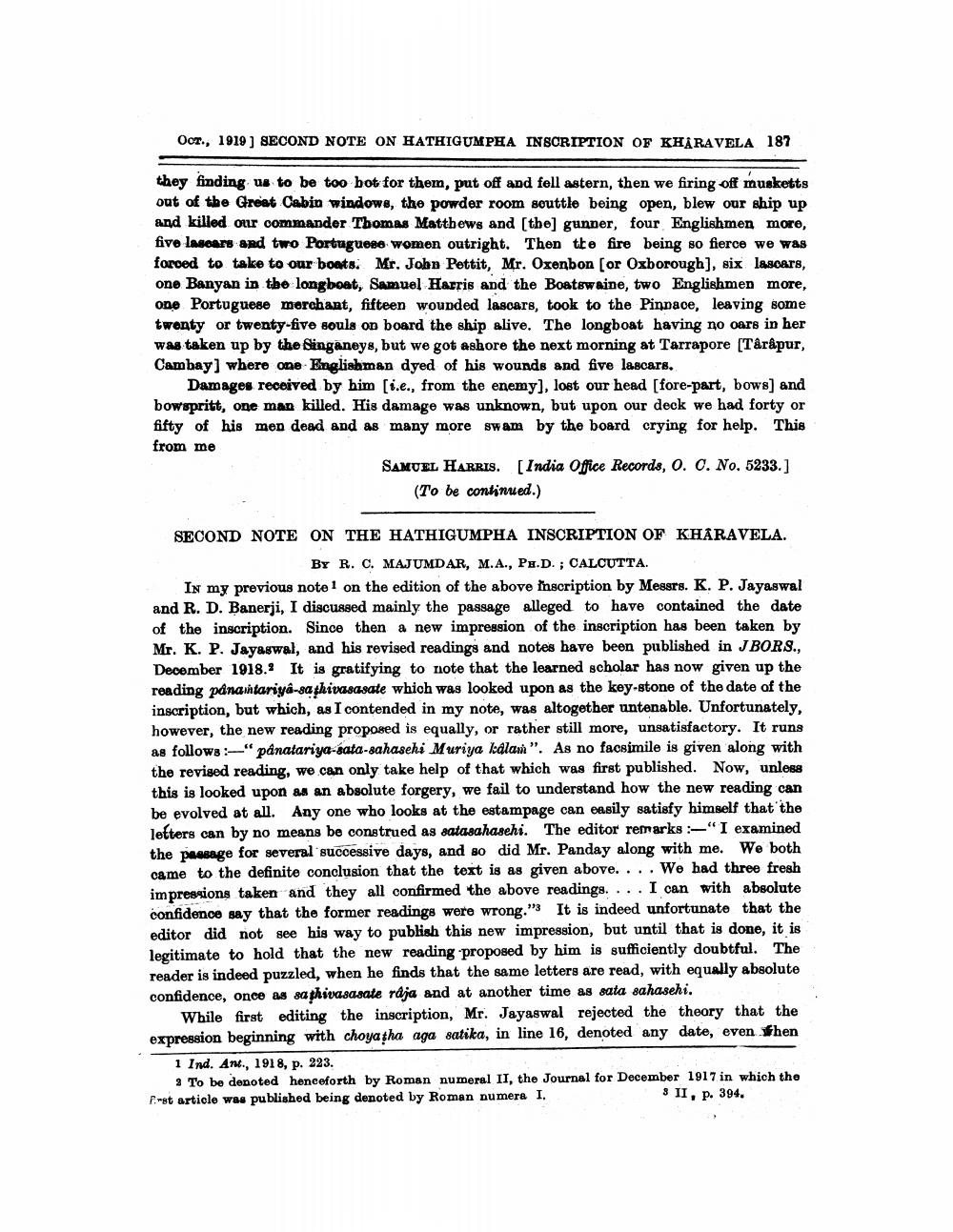________________
Oct., 1919 ) SECOND NOTE ON HATHIGUMPHA INSCRIPTION OF KHARAVELA 187
they finding us to be too bot for them, put off and fell astern, then we firing off musketts out of the Great Cabin windows, the powder room souttle being open, blew our ship up and killed our commander Thomas Matthews and [the] gunner, four Englishmen more, five lascars and two Portuguese women outright. Then the fire being so fierce we was foroed to take to our boats. Mr. John Pettit, Mr. Oxenbon (or Oxborough), six lascars, one Banyan in the longboat, Samuel Harris and the Boatswaine, two Englishmen more, one Portuguese morchant, fifteen wounded lascars, took to the Pinnace, leaving some twonty or twenty-five souls on board the ship alive. The longboat having no oars in her was taken up by the Singaneys, but we got ashore the next morning at Tarrapore (Târåpur, Cambay) where one Englishman dyed of his wounds and five lascars.
Damages received by him [i.e., from the enemy], lost our head [fore-part, bows) and bowspritt, one man killed. His damage was unknown, but upon our deck we had forty or fifty of his men dead and as many more swam by the board crying for help. This from me
SAMUEL HARRIS. [India Office Records, O. O. No. 5233.]
(To be continued.)
SECOND NOTE ON THE HATHIGUMPHA INSCRIPTION OF KHARAVELA.
BY R. C. MAJUMDAR, M.A., PH.D.; CALCUTTA. In my previous note 1 on the edition of the above inscription by Messrs. K. P. Jayaswal and R. D. Banerji, I discussed mainly the passage alleged to have contained the date of the inscription. Since then a new impression of the inscription has been taken by Mr. K. P. Jayaswal, and his revised readings and notes have been published in J BORS.. December 1918. It is gratifying to note that the learned scholar has now given up the reading panahtariya-sa thivasasate which was looked upon as the key-stone of the date of the inscription, but which, as I contended in my note, was altogether untenable. Unfortunately, however, the new reading proposed is equally, or rather still more, unsatisfactory. It runs as follows:-"panatariya-sata-sahasehi Muriya kalaw". As no facsimile is given along with the revised reading, we can only take help of that which was first published. Now, unless this is looked upon as an absolute forgery, we fail to understand how the new reading can be evolved at all. Any one who looks at the estampage can easily satisfy himself that the letters can by no means be construed as satasahasehi. The editor remarks -"I examined the passage for several successive days, and so did Mr. Panday along with me. We both came to the definite conclusion that the text is as given above. ... We had three fresh impressions taken and they all confirmed the above readings.... I can with absolute confidence say that the former readings were wrong." It is indeed unfortunate that the editor did not see his way to publish this new impression, but until that is done, it is legitimate to hold that the new reading proposed by him is sufficiently doubtful. The reader is indeed puzzled, when he finds that the same letters are read, with equally absolute confidence, once as sa phivasasate raja and at another time as sata sahasehi.
While first editing the inscription, Mr. Jayaswal rejected the theory that the expression beginning with choya tha aga satika, in line 16, denoted any date, even then
1 Ind. An., 1918, p. 223.
To be denoted henceforth by Roman numeral II, the Journal for December 1917 in which the Pret article was published being denoted by Roman numera I.
3 II, p. 394.




